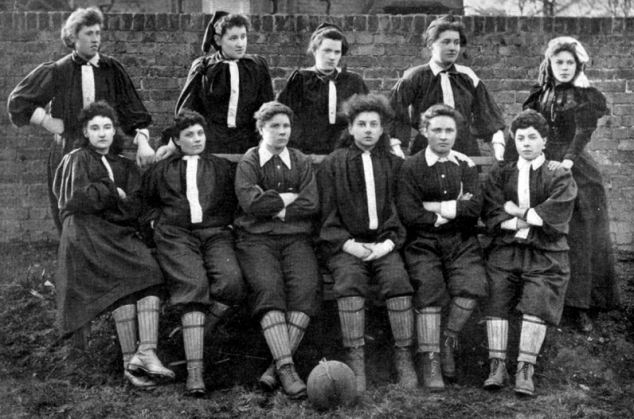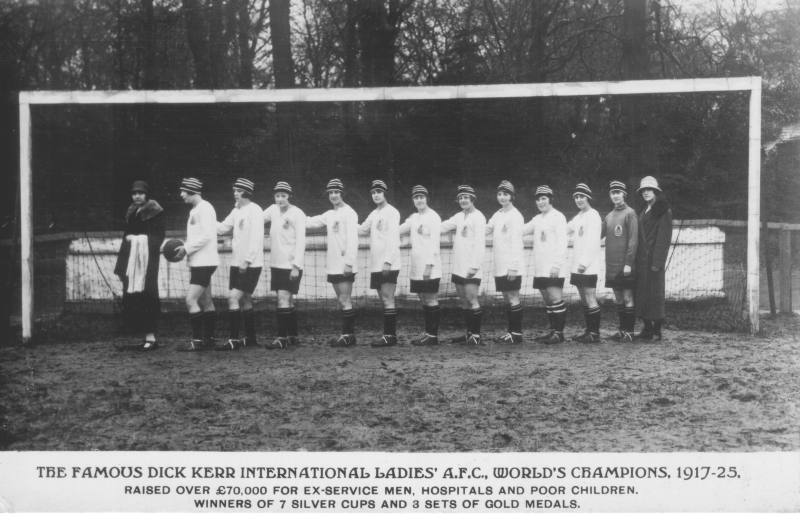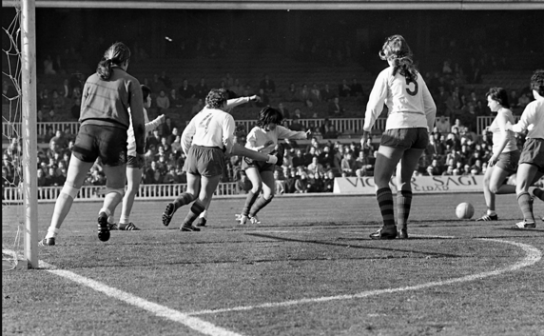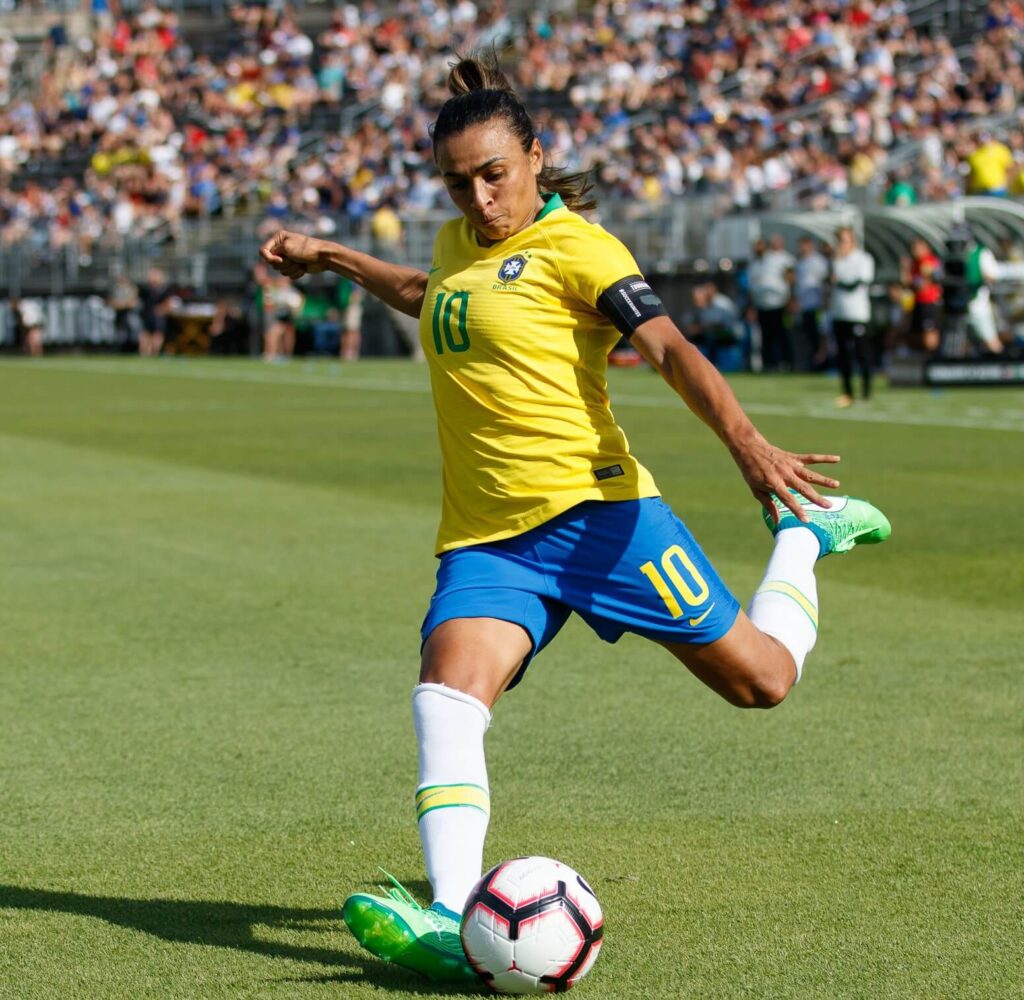Last Updated on: 3rd March 2025, 01:42 pm
Women’s Football Facts
The History of Women’s Football
Women’s football has become one of the fastest-growing sports in the world. According to FIFA, women’s football participation has grown by over 200% in the last decade, with millions of girls and women playing globally. It hasn’t always been that way. Unlike the men’s game, there were decades of setbacks for female players. They needed to push boundaries to get the recognition they deserved. The history of women’s football is full of resilience, passion, and unstoppable progress. We’ve collected a few fascinating facts to shine a light on the incredible journey of women’s football.

British Ladies Football Club North Team in 1895
1. The First Ever Recorded Women’s Match
The first recorded women’s football match took place on 7 May 1881, between teams from Scotland and England. Although, the birthplace and nationalities of the players have been called into question over the years. It’s believed that at least some of the players were from the theatre community simply acting out these team roles. During the match, Lily St Clair scored the first goal, making her the first recorded female goal scorer in history. In the end, Scotland won the match 2-0.
The teams played two more matches, in Glasgow and Manchester, but both were abandoned due to pitch invasions. The press coverage of the matches was critical of the womens’ appearance and the standard of play.
2. Women’s Football In World War 1
After 1881, women’s football began to gain momentum. Local clubs competed against each other in matches and competitions. In London, the British Ladies’ Football Club was formed in 1895 by Alfred Hewitt Smith. Nettie J. Honeyball (thought to be a pseudonym) was captain and Lady Florence Dixie acted as President. Over 10,000 spectators paid to watch the BLFC play a North vs South of the Thames match on 23 March 1895. The sport was gaining popularity amongst players and spectators.
During World War I, women’s football thrived as men were away fighting. At the time, women had taken over a lot of traditionally male jobs, particularly as factory workers. These women were encouraged to take part in sporting activities for their health and wellbeing. It was also great for increasing morale and productivity. So, female factory workers formed teams and started to play. One of the most famous teams was from Dick, Kerr & Co. Dick, Kerr Ladies Football Club remained in existence from 1917 to 1965. Over 48 years they played 755 games. Of those, the women won 682, drew 39, and lost 34.

Dick Kerr Ladies Football Team in 1925
3. Women’s Football was Banned in 1921
Despite its growing popularity, women’s football encountered a huge setback after the war. The FA banned the sport in the early 1920s. On December 5th 1921, they prevented female footballers from playing on FA pitches and banned FA members from acting as referees and linesmen at their games. The FA released a statement saying it thought that football was “quite unsuitable for females and ought not to be encouraged”. Several doctors agreed that the sport posed a serious physical risk to women.
The ban relegated women to only playing football recreationally. At least until 1971, when the FA lifted its ban following the formation of the Women’s Football Association a few years earlier. To find out more about these dark days in women’s football history historyextra.com has a great article about it.
4. The FIFA Women’s World Cup Began in 1991
The men’s FIFA World Cup started in 1930 but it took another 60 years before the women got their chance. The first FIFA Women’s World Cup took place in 1991 in Guangdong, China. 12 teams qualified for the tournament held in November. For only the inaugural Women’s World Cup, matches only lasted for 80 minutes and two points were awarded for a win. Ultimately, the United States became the first winners after defeating Norway 2-1. The final match was played in front of a crowd of 63,000 people at Guangzhou’s Tianhe Stadium. Total attendance for the tournament was 510,000, an average per match of 19,615. Since then, the women’s tournament has become one of the biggest sporting events in the world.

Barcelona’s first recognised women’s team, 1970
5. The “Unofficial” Women’s World Cup in 1970
Before FIFA officially recognised the Women’s World Cup in 1991, an unofficial event took place in 1970. It was held in Italy and was organised by the Federation of Independent European Female Football (FIEFF). Teams from seven countries competed in the unofficial tournament but it was Denmark who came away with the title. They beat the host nation, Italy, 2-0 in the final. England’s team came fourth after losing to Mexico.
A second unofficially Women’s World Cup was held in Mexico in 1971. This tournament featured six national teams from Latin America and Europe qualifying to compete. Denmark defended its title after winning 3-0 against Mexico. This final match was watched by a 110,000 crowd, which was a record that stood for decades. The team from England have since become known as the Lost Lionesses because they were disbanded after returning from Mexico. The team were reunited in 2019 after nearly 50 years apart.
6. Equal Pay Movements Have Gained Momentum
There’s a long history of pay disparity between men’s and women’s football. However, things have slowly started to improve. Recently, teams like the US Women’s National Team have been at the forefront of the fight for equal pay. In 2022, the USWNT made history after getting equal pay with the men’s team. This includes equal prize money distribution from FIFA tournaments.
Although, it was Norway that became the first country to introduce equal pay for its men’s and women’s national teams. The Norwegian Football Federation agreed to double the salaries of female players, ensuring that teams earned the same amount for international duty.

Marta playing for Brazil, 2018 by Amy Pearson / BDZ Sports [CC SA 4.0], via Wikimedia Commons
7. Marta Vieira da Silva has the nickname “Pelé in skirts”
Some people regard Brazil’s Marta as the greatest female player of all time. She has been named FIFA World Player of the Year six times. For five consecutive years between 2006 and 2010 and most recently in 2018. This is not only a record for female players but for men too. During her career, Marta has scored 17 goals in the FIFA Women’s World Cup. That’s the most of any player, male or female, in World Cup history. And that’s just the start of her records and achievements! Marta is a fantastic player and an inspiration. You can see just what she’s capable of with this goal against the USA in the 2007 World Cup.
8. Lyon Has Dominated Women’s Club Football
French club Olympique Lyonnais Féminin (Lyon) one of the most successful women’s football teams in the world, with multiple league and Champions League titles. They have won the UEFA Women’s Champions League eight times, including five consecutive titles from 2016 to 2020. The team has also won 14 consecutive domestic league titles from 2007 to 2020. Lyon then became the first club to win 100 UEFA Women’s Champions League games in 2022/23.
In terms of players, Lyon has had some big names over the years. Wendie Renard and Eugénie Le Sommer have won 8 titles each, which makes them joint record holders. Some also consider Renard to be the best defender in the world.
9. Bob Marley’s daughter is part of the reason Jamaica was at the 2019 World Cup
The Reggae Girlz are Jamaica’s national women’s team and were the first Caribbean squad to ever compete at the Women’s World Cup. They obviously did it by proving their skills on the pitch but they also had a bit of help from Reggae royalty. Cedella Marley, the eldest daughter of Bob Marley, helped revive the team. Back in 2010, the team got their funding cut in favour of the men’s team. When Cedella heard about this, she spearheaded a campaign to raise funds for the women’s team. Cedella donated her own money and created a song, “Strike Hard”, in honour of the campaign.
10. The 2023 Women’s World Cup Was the Biggest Ever
The 2023 FIFA Women’s World Cup was hosted by Australia and New Zealand. Not only was it the biggest tournament to date but it was a significant moment in the sport’s history. For the first time, the Women’s World Cup featured 32 teams instead of the 24 in 2019. this expansion meant that the women’s tournament matched the men’s World Cup format, so more nations got the chance to compete.
The tournament saw record-breaking attendance with over 1.9 millions fans visiting stadiums across the host countries. The opening match between New Zealand and Norway set a national record with 42,137 spectators. The tournament also reached over 2 billion viewers around the world on multiple platforms. More than 75 million people worldwide watched England take on Spain in the final.
If our facts have inspired you, check out our range of women’s football kits.
Get Your New Women’s Football Kit




